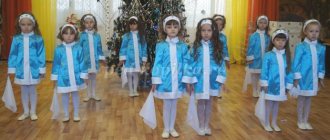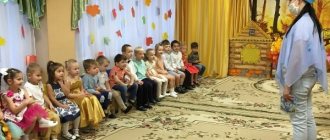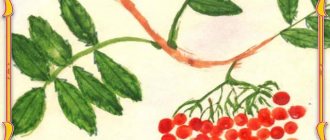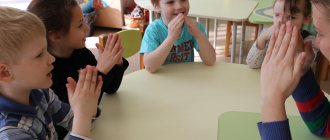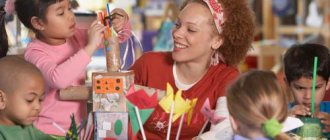Dancing with leaves is one of the most popular and in demand at autumn matinees in kindergarten. They are distinguished by accessibility, relevance and beauty.
You can cut the leaves yourself from cardboard or isolon. As a rule, maple or oak leaves are used. They have a beautiful shape and variations in color are possible: green, yellow, orange, red. But more complex options are also possible, for example, dancing with a mountain ash. At the end of the article I will provide a link to my templates for autumn leaves.
In addition, children of all ages can dance with leaves - from juniors to pre-schoolers. It can be like an entrance to a matinee, where there is an independent production.
Junior group. Dancing with leaves
Kids with leaves. Dance for children of primary preschool age to the composition “Oak leaves, maple leaves.” Performed by Lyayla Khismatullina.
Swing over me, My golden leaf. Oak leaves, maple leaves.
We are sitting behind a leaf, looking from behind a leaf. Oak leaves, maple leaves.
Suddenly a cheerful breeze wants to tear out my leaf. Oak leaves, maple leaves.
We won’t give you the leaflet, it will be useful to us ourselves. Oak leaves, maple leaves!
Junior group. You are a naughty leaf
Music and lyrics by Alla Evtodieva, song “You are a mischievous leaf.”
1. You naughty little leaf, fly after me, fly, fly, catch up with our children.
2. Our breeze blew, our leaf swayed, sway my golden leaf over me!
3. We lower the leaf, swing the leaves up and down, The legs will squat and dance with the leaves!
4. Where the children have leaves, they sleep quietly on their heads, A leaf sleeps, another sleeps, the mischievous wind sleeps too!
5. We are sitting behind a leaf, looking from behind a leaf, There are no kids, find them quickly! Where are the kids? Here they are!
6. Our leaves are spinning, we will dance with them. Our leaves are good, just like our babies!
7. Then the breeze woke up and the leaf rushed and rushed, Our legs ran, the tiny children ran!
8. We’ll collect a bouquet and go dancing again. Our bouquet is good, you won’t even find a better one! You simply won't find anything better! You won't find anything better!
A selection of rhythmic exercises for children 3-4 years old
Select exercises for rhythmic classes in such a way that children enjoy doing them and at the same time receive tangible benefits - they develop coordination of movements and a sense of rhythm.
Rhythmic echo
Goal: to teach children to hear the rhythm of music.
Children stand in a circle. A short excerpt of a simple piece of music begins to sound, for example, “Chickens” or “Two Cheerful Geese.” The children's task is to exactly repeat the rhythm of the music by clapping their hands. If children have mastered a simple melody, you can increase the duration of the musical segment.
Faster-slower
Goal: to teach children to respond to the rhythm of music and quickly switch from one rhythm to another, to develop attention and improve walking and running skills.
Children stand in a circle and begin to step one after another with their left foot to the beat of the music. As soon as the melody speeds up, the children start running. During the exercise, you can change the speed of the songs several times. For musical accompaniment, we recommend using the melodies “Polka” and “About the Siskin”.
Soldier's March
Goal: to develop a sense of tact in children.
Children stand in a line one after another and choose a “commander”. The teacher plays the song “Soldier's March”. The children’s task is to sit down and stand up for each new musical phrase, and bend over and stand up for the next phrase. And so several times in a row.
Freeze
Goal: to teach a child to express his feelings and emotions through dance.
Children move freely around the hall to the music and dance freely. As soon as the music stops, they should freeze in place in the position they were in. The teacher talks to the kids about why they stopped in this particular position and what it means from an emotional point of view. Then another melody starts playing and the exercise is repeated.
The wind blows
Goal: relax after the active part of the lesson and restore breathing.
Children stand in a circle, the teacher turns on a slow lullaby and says: “We will blow far, we will blow close.”
When hearing the words “we will blow far away,” the children begin to blow very, very hard, but when they say “we will blow close,” on the contrary, they begin to blow weakly and weakly. And so on several times.
Follow the described recommendations when building rhythm classes, and the children will happily run to each lesson. In the next article you will learn about rhythmic exercises for children 5-7 years old.
Middle group. We're walking through the woods
Yulia Seliverstova's song is perfect for middle-aged children. Children's movements are more confident and clear, you can experiment with round dances and formations.
We walk through the forest and collect leaves! We’ll collect it when there’s an Autumn portrait in the bouquet! The leaf is yellow-yellow-yellow. Quickly take it into your hand and quietly let it go!
We walk through the forest and collect leaves! We’ll collect it when there’s an Autumn portrait in the bouquet! Let's quickly take the leaf, red-red-red, into your hand and quietly let it go!
We walk through the forest and collect leaves! We’ll collect it when there’s an Autumn portrait in the bouquet! A red leaf, a yellow leaf, quickly take it into your hands and bring it to a bouquet!
We walked through the forest and collected leaves. This is our bouquet. The best autumn portrait! Now let’s take the leaves, And make the guys happy, One two three four five, We’ll arrange a leaf fall!
Animated dances for children. Video
Animashki! Fun dances with simple movements. Ideal - 3 movements. Sometimes 6, no more. I'm not a choreographer and neither are most people. But we all love to dance! Because it's fun, it energizes us.
Dancing becomes even more interesting if you come up with a plot for it. For example.
Barbariki "Friendship"
I invented this dance myself! Music can be easily downloaded on the Internet, on VK or on any other site.
Introduction to the dance “Friendship” by Barbarika
I ask the children: is it good to be friends? funny? And if a friend feels bad, sad, what can we do for him? The children answer. Me: do you know that all children are a little kind wizards and can perform good miracles?
Let's create a miracle: turn on the sun ! Draw the sun with your hands. The heart clenches all the warmth into fists and now they throw it at their friends (sharply unclenching their hands), to the sides, again. And now they stretched their arms forward. Are your palms warmer? So a miracle happened!
The palms actually become warmer because we caused a rush of blood. But the children believe - it’s a miracle!
Watch the video at the end of the article and everything will become even clearer
The Bears
The song is familiar and loved by more than one generation. Let's get to the plot of the dance . We ask: why does summer and winter, day and night change? Why is this happening? Children explain that the earth rotates... And who spins it? do not know? I'll tell you: polar bears move the earth. But for some reason they were sad, and that’s why our weather is strange. let's help them
And we dance. Then the music is repeated with acceleration several times
If you need a photogram cut, I will send it to you for free. Contact me.
What attracts the bird
A good lead-in to the dance is to ask: do you know animals? What about the birds? And the fish? Show them to me. Now let's make it the same. We show moves and dance.
What to do on the verses? Before this dance, I usually introduce the children to the ribbon and teach them to walk in a looping step. When it works out, we start doing it cool, important, and it’s easier to say show off . (usually laughter here)
And in the song we perform movements at the chorus, and at the verses we show off - we walk in a circle with this meandering step, but with a show off.
Flash mob for children with movements
This is a more modern name for animation dances, dances with repetition of movements. Adults are actively involved in the children's flash mob. This is a great way to have a birthday party with virtually no props.
Flash mobs (animations, game dances) can easily be implemented into any scenario and will replace many competitions at a children's party, or diversify them. Especially if the children are active.
At a kindergarten or school graduation, or for a large group of children, animations are simply a lifesaver! Dancing brings joy to even kids and they repeat the movements with pleasure. This is very nice!
Middle group. Golden Day invites us
Children stand in 2 or 3 rows towards the auditorium. In the hands are leaves of isolon.
The golden day invites us, invites us to take a walk. A golden day offers us an offer to play.
CHORUS: Look like little lights, Lights-lights, Our multi-colored leaves, Our leaves-leaves.
We are like forest butterflies, flying through a clearing. The wings are painted leaves, and they are not afraid of the rain.
Can we shield ourselves from the rain with our little leaf? We can’t rush home - Under a leaf, like under an umbrella.
The breeze plays with us - All the leaves rustle, merrily change places and fly, fly, fly.
Dance "Dolls" for the New Year middle group
Kindergarteners can also reproduce this dance without much difficulty, since all the movements are simple. Most often, this choreographic work is performed by girls, they wear identical dresses (you should think about sewing or renting in advance) and multi-colored wigs (similar to Malvina).
In such costumes, a newly formed choreographic ensemble can perform to numerous musical compositions, but today Zhenya Lyubich’s song “Lullaby of Silence” is very popular. You can also find many songs from unknown artists called “Doll”.
Among the characteristic movements the following are noted:
- stamping;
- whirling;
- clapping hands;
- jumping.
Middle group. Dance with rowan
Girls of the middle group dance with a sprig of rowan. Song “There is a shadow on the path”, lyrics by Elena Blagina.
On the path there is shadow-shadow-shadow, Solar net. Through the tyn, through the fence, a branch bent.
I’ll come running, I’ll gallop, I’ll stand up on my toes! I’ll grab the branch by the braid and get the berries!
Chorus: Berries, berries, rowan berries. Berries, berries, rowan berries.
I’ll sit by the fence, and carefully string a rowan berry onto the silk.
Put on your bitter beads, become smart, branch! On the path there is shadow-shadow-shadow, Solar net.
Senior group. Entrance to the matinee with leaves
The guys in the older group dance to the song “Dance with Autumn.” Song author Tatyana Petrova, arrangement Alexander Zorin, performer Alina Afanasova.
Look at the leaf - it’s burning like a lantern. The leaf wants to dance - He flies in the dance with us!
We put the foot on the toe and knock everything with the heel. We will add smooth gestures, And then we will spin.
The Beauty Queen invited us to dance. She gave me a leaf, traces of autumn everywhere...
Autumn in polka circles with us, Sings a song merrily. Today we will all become friends with our autumn round dance.
Consultation “Teaching dance to preschoolers”
One day a man came to a sage and said to him: “O Sage, teach me to distinguish truth from lies, beauty from ugliness. Teach me the joys of life." The Sage thought and... taught the Man to dance.
Dance is a synthetic art. It is aimed at solving the musical-rhythmic, physical, aesthetic and mental development of children. Movements to music accustom them to collective action and help foster a sense of collectivism, friendship, camaraderie, and mutual respect.
Currently, the attention of children and teachers is attracted by modern rhythms of music and new dances. But sometimes you have to deal with the fact that children, watching adults dance in everyday life, imitate the worst examples of their performance (they make faces, break, dance rudely, unmusically). This causes great concern, since it is in preschool age that the foundations of artistic and musical taste are laid.
It is easier for children to convey their understanding of music not through words, but through movements. And this is a good prerequisite for the creative process.
To teach a child to convey the character of a musical work, its figurative content through the plasticity of movements to music - this is exactly what the work on dance is aimed at.
By acquiring knowledge and skills in the field of dance art, children begin to understand that each dance has its own content, character, and image. To convey the expressiveness of dance images, the child must remember not only the movements themselves, but also their sequence (which in itself has a positive effect on the development of memory and attention), but also mobilize imagination, observation, and creative activity.
Types of dances
- dances and dances with fixed movements, the construction of which is determined by the structure of the musical work;
- free dances and dances , in which the creative abilities of the performers are most clearly manifested;
- combined dances , including fixed movements and free improvisation;
- folk dances and dances based on authentic elements of folk dance;
- character dances performed by various characters;
- children's ballroom dancing , including polka steps, gallop, waltz movements and others.
Creation of children's dances
The first way is to work on lightweight versions of existing dances for adults, accessible to children, using the same music. They preserve the dance movements for adults and its pattern, but reduce the number of figures, simplify the composition, and eliminate the most difficult elements for children to perform.
Another way is to create a new children's dance based on music that children like and that is suitable in terms of musical structure and form. Such dances include program dance skills required for preschoolers (springs, hops, galloping steps, side steps, rhythmic claps, etc.), many of which are performed in a new modern manner. At the same time, new elements are introduced.
Methodical techniques
Display method: involving display (joint execution of movements), advanced display, fragmentary display.
By showing children movements, the teacher gives them the opportunity to see the artistic embodiment of the image.
Verbal method. Spoken speech is the link between movements and music.
Verbal explanations should be brief, precise, figurative and specific. It is also necessary to pay attention to intonation and the force with which the word is spoken.
Words are symbols denoting movements: “sun”, “house”, “balls”, “tails”.
Gestures with spoken words that reveal the meaning of this gesture: “why are you sitting here”...
Illustrative visualization method. A full-fledged activity cannot take place without a story about dances, their history and diversity, without introducing reproductions, book illustrations, photographs and videos. Hall markings. Schemes-cards.
Game method. The essence of the play method is that the teacher selects toys for children that help in learning. Toys ( attributes ) decorate the dance and have a great influence on its performance. Captivated by the toy, children stop fixating their attention on the technical features of the dance. Transformation games will help teach children to perform expressive movements and develop their imagination and creativity.
Concentric method. This method consists in the fact that the teacher, as the children master certain movements and dance compositions, returns to what they have learned, but can now offer a more complicated version.
Showing children performing this or that movement well.
Stages of learning musical-rhythmic movements
Stage I – initial training in new musical movements; Stage II – in-depth learning; Stage III – consolidation and improvement of musical and rhythmic movements.
Training at the first stage is aimed at creating in children a general understanding of the new movement in connection with music. To interest children in dance, the teacher must give a general description of the dance and note its features. Listening to dance music, understanding its content and features, and analyzing its structure (individual parts, musical phrases) is of great importance. Children can be asked to clap accents, rhythmic patterns, the beginning of a new part, or a musical phrase.
The main actions of the teacher at the first stage of training:
- explanation;
- expressive performance;
- demonstration of a new dance movement by the teacher, corresponding to the content of the music.
At the second stage of training, as a result of the active work of the teacher and children (in small groups and individually), mastery of basic movements in conjunction with music occurs.
The teacher analyzes in advance what mistakes children may encounter when mastering a particular movement, finds the exact words to explain individual details, thinks through figurative comparisons, clear brief instructions, and uses preparatory dance exercises.
Children can stand scattered or in a general circle, in this case they can clearly see the teacher’s demonstration (no one stands with their back or side to him), and the teacher, in turn, has the opportunity to control the quality of movements. If children stand scattered, the teacher’s display should be mirrored.
The teacher must constantly monitor the children’s movements in accordance with the tempo, rhythm, dynamic shades of music, correct mistakes, and encourage them.
The main features of a developed musical motor skill are the conscious execution of movements in accordance with the nature of the music and the quality of execution (accuracy, rhythm, expressiveness).
At the third stage , the task is to bring the skills acquired by children in musical and rhythmic movement to the degree of independent creative performance and use of dances and games in everyday life. Children approach independent creativity gradually, through feasible or creative tasks, which are offered in sequence from simple to more complex.
Stages of learning exercises:
1. Verbal explanation by the teacher, then demonstration of the exercise by the teacher accompanied by musical accompaniment. 2. Learning complex movements (“variable step”, “polka step”...) according to
in parts, first to the count, then to the music. 3. Show a child who has mastered this exercise. 4. Reinforcement of the exercise by all children in subsequent classes. 5. Assessing the children’s performance of the exercise.
Dance - improvisation
Dance improvisation is a way to develop creative abilities and nurture creativity in preschoolers. Children are characterized by a rich imagination and imagination. Therefore, games, free improvisations, plastic performances arouse their interest and enthusiasm, and are performed easily and naturally. Such exercises should be performed by children in classes throughout the year.
“Choreography implies “ownership” of the body; the body in this case is the object towards which the action is directed.
Improvisation involves co-creation with the body, recognition of the equal importance of pre-formed plans and experiences, and momentary impulses. For improvisation, you need a feeling and “thinking” body, something that was present in ancient cultures based on the idea of “unity with nature” - Grishon A.E.
Feelings of body freedom contribute to the development of the ability to improvise.
In classes with preschoolers, several areas for developing the ability to improvise can be distinguished:
1. Feeling of the “body”.
2. Communication with a partner - partnering.
3. Understanding movement in creativity: drawing, crafts….
4. A set of movements to create a basic basis for improvisation.
, musical sketches provide invaluable assistance for example from E. Gorshkova’s methodology “From Gesture to Dance” (“Met”, “In the Forest”, “Let’s Be Friends”, “Secret”). And also studies on the expression of emotions, on the reproduction of individual character traits, on the training of individual muscle groups by M. Chistyakova from her book “Psychogymnastics”. For example, such as “Barbell”, “Icicle”, “Everyone is Sleeping”, “Different Moods”, “Sentry”, “Fear”, etc. In them, children learn with interest to communicate with each other using the language of movements, to convey in plastic various emotional states that are close to them from their own life experience.
It is useful to use communicative, character and plot improvisations with poetic or prose accompaniment.
Communicative dance is a dance with simple, light, playful components, and evokes a lot of positive emotions in children (Briske’s Dance “For me, for you,” Zheleznov’s disc: “Dwarfs and Giants.”)
Characteristic dances: of a character (Zheleznov’s “Three Little Bears”).
Logorhythmic exercises: “Cat’s house”, “The cat inflated the ball”.
Then, when children get used to this kind of tasks, improvise freely and naturally, show creative independence and activity, you can introduce free improvisations with objects (Briske dance with hoops “To the village to visit grandma”: sun, hat, skirt, house.)
The main requirement for dance improvisation is that each improvisation is performed only once, since if the composition is repeated, it loses the character of creativity and improvisation.
Game "Body Parts". We study body parts. After getting to know each other, you are given the task to move (dance) a certain part of the body. The movements are based on improvisation. At the next stage of the game, the tasks become more complicated: speed and movement dynamics are added.
Exercise "Mirror". Children look in the mirror, “make faces”, developing facial muscles, then the task becomes more complicated, the child must convey these facial sensations without looking in the mirror. In this way, internal sensations develop. An option to complicate the game: children become pairs: one depicts a mirror, the second a reflection. The task is to make the mirror and reflection unrecognizable.
It is important to create a comfortable atmosphere in the team, teach children to communicate with each other, and trust each other.
Game "Partnership". Children become pairs (the teacher first observes who is in contact with whom), one in the pair closes his eyes, completely trusting his partner, who sends impulses to the partner’s back with his palm, directing his movement. The task of the second is to guide the partner without clashes, the first is to completely trust the partner.
"Imagine who you are" technique . Children close their eyes. The teacher gives the task to imagine yourself as a bird. A story about what kind of bird it is helps the child imagine it in his imagination. The performances then need to be shown in motion. Observation of natural phenomena stimulates imagination and moves towards improvisation. It is necessary to give the task more often: observe a phenomenon, animal, object, and then talk about it in class.
Game "Word Action". The teacher names the quality of movement. For example: a tree is swinging (swaying), a sweet toffee (stretching), we are rolling a roll (twisting), we are late (walking, running). To complicate the exercise, you can independently compose stories based on your experience. Mastering the technique broadens the child’s horizons.
The game "Silent" requires a little experience in movements. Goal: carefully monitor the changing movements of the teacher, who is silent and makes them as he moves around the hall, and repeat the movements. The result can be very unexpected: children, carried away, actively enter into the process and begin to independently compose movements, as if not noticing everyone around them; this is an excellent result in the development of the ability to improvise in preschoolers.
Not all children succeed in completing tasks, because we are talking about creativity, which requires choreographic talent and talent. Children who did not get the expected result have their own reasons: personal, psychological, etc. And yet, for them, the techniques used are also useful in terms of art therapy.
“Of all the feelings, joy has the best influence on the development of a child’s abilities; he most willingly surrenders to this feeling and his soul is open to educational influence” Emile Jacques-Dalcroze.
Literature:
1. Grishon A.E. Improvisation and choreography [Electronic resource] - Access mode. — URL: https://www.girshon.ru/index.php/moi-stati/articles/improvizacija-i-xoreografija.html (access date 08/12/2013).
2. Literature and language: modern illustrated encyclopedia [Text] / Ed. A.P. Gorkina. M.: Rosman, 2006. - 584 p.
3. Samukina N.V. Games at school and at home: psychotechnical exercises and correctional programs [Text] / N.V. Samoukina. M., 1993. - 144 p.
4. Churilova E.G. Methods and organization of theatrical activities for preschoolers and primary schoolchildren [Text]: Program and repertoire / E.G. Churilova. M., 2001. - 160 p.
Preparatory group. Dance "Falling Leaves".
The older the children, the more complex the movements and dances. The preparatory group dances to the song “It’s not easy to rain today.” Author - N. Naydenova, arrangement - Alexander Zorin, vocals - Marina Melnik.
Today the rain is not simple, today the rain is golden! He is not aquatic at all, there is not a single cloud.
Leaf fall, leaf fall! Leaves are spinning, flying, Leaves are flying in the wind, Falling leaves!
Autumn day is so good, How many leaves can you collect! Golden large bouquet - Greetings from autumn to us!
Leaf fall, leaf fall! Leaves are spinning, flying, Leaves are flying in the wind, Falling leaves!
Preparatory group. Exercise with leaves “Birch tree, rowan tree”
Amazing composition by Dmitry Kabalevsky to the words of Anton Prishelets.
Now a birch tree, now a rowan tree, A willow bush over the river: My native land, forever loved, Where else can you find one like this?! My native land, forever beloved, Where else can you find something like this?! Where else can you find one like this?!
From the seas to the high mountains, In the middle of our native latitudes, The roads are always running, And they are calling forward. Everyone is running, the roads are running, And they are calling forward. And they call forward.
The valleys are filled with the sun, and wherever you look, the native land, forever loved, is all in bloom, like a spring garden. My native land, forever beloved, is in full bloom like a spring garden. Everything is blooming like a spring garden.
Our golden childhood is getting brighter every day, Under a happy star We live in our native land! Under a lucky star We live in our native land! We live in our native land!
